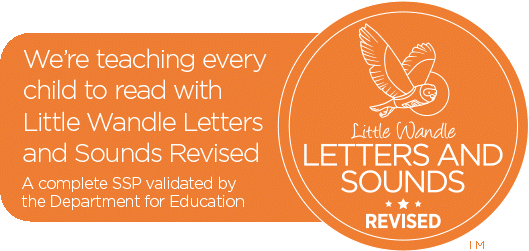How We Teach Phonics
At Purlwell Infant and Nursery School we believe that for all our children to become fluent readers and writers, phonics must be taught through a systematic and structured phonics programme.

We use the Little Wandle Letters and Sounds Revised to plan and provide daily engaging phonics lessons. In phonics, we teach children that the letters of the alphabet represent a different sound, that these can be used in a variety of combinations and are put together to make words. The children learn to recognise all of the different sounds and combinations that they might see when they are reading or writing. Our phonics teaching starts in Nursery and follows a very specific sequence that allows our children to build on their previous phonic knowledge and master specific phonic strategies as they move through school. As a result, all our children are able to tackle any unfamiliar words that they might discover. At Purlwell we also model these strategies in reading and writing both inside and outside of the phonics lesson and across the curriculum. We have a strong focus on the development of language skills for our children because we know that speaking and listening are crucial skills for reading and writing in all subjects.
How We Teach Phonics and Early Reading (Early Years and KS1)
- In the nursery, children follow the Little Wandle Letters and Sounds Revised ‘Foundations for Phonics’ guidance. The focus is on daily oral blending and language development through high quality stories and rhymes.
- In reception and Y1 and Y2 children follow the progression within Little Wandle Letters and Sounds Revised programme. Phonics is taught daily and there is a review session on a Friday.
- By the end of reception, children will have been taught up to the end of Phase 4.
- By the end of year 1, children will have been taught up to the end of phase 5.
- Children in year 2 recap any gaps in their phonics knowledge and develop spelling strategies using their phonic knowledge.
- Reception lessons start at 15 minutes, with daily additional oral blending – increasing to 20 to 30 minutes.
How do we assess phonic knowledge?
- In reception, year 1 and year 2 at the end of each week there is a review session which recaps the learning. There are also whole review weeks (pre-planned and bespoke review weeks to address gaps identified by the class teacher’s ongoing formative assessment).
- Children in reception, year 1 and year 2 in danger of falling behind are immediately identified and daily ‘keep up’ sessions are put in place – these sessions follow the Little Wandle Letters and Sounds Revised programme.
- In reception and year 1, the children are assessed at the end of every half term using the Little Wandle Letters and Sounds Revised assessment tracker.
- Children in year 1 complete the statutory Phonics Screening Check in the summer term.
- Children who do not meet standard in the Phonics Screening Check in Y1, will complete this in Y2. Support continues to be put in place for these children.
Parental Support
Supporting your child is a vital part of them learning to phonically decode words to read them and write them. Pronouncing the graphemes can be tricky but below are some videos that may help you.
There is lots of advice and support on the Little Wandle website
https://www.littlewandlelettersandsounds.org.uk/resources/for-parents/

